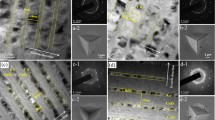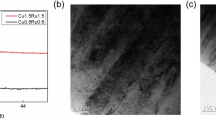Abstract
The mechanical response to indentation (including nano- and microindentation) has been investigated in Cu/Au and Cu/Cr multilayers with respective layer thickness ratios of 1:1 and 2:1, and individual layer thickness ranging from nanometer to submicrometer scale. It was found that the Cu/Cr multilayer has higher strength than the Cu/Au multilayer, although both multilayers have close Hall–Petch slope. Examination of indentationinduced deformation behavior shows that the Cu/Cr multilayer exhibits higher resistance to plastic deformation instability than the Cu/Au multilayer. Theoretical analysis indicates that the significant difference in mechanical response originates from the constituent layer configuration and interface structures, which impose distinguishing confining effect on dislocation activity.
Similar content being viewed by others
References
K.O. Schweitz, J. Chevallier, and J. Bøttiger: Hardness in Ag/Ni, Au/Ni and Cu/Ni multilayers. Philos. Mag. A 81, 2021 (2001).
A. Misra, M. Verdier, Y.C. Lu, H. Kung, T.E. Mitchell, M. Nastasi, and J.D. Embury: Structure and mechanical properties of Cu–X (X = Nb, Cr, Ni) nanolayered composites. Scr. Mater. 39, 555 (1998).
J. McKeown, A. Misra, H. Kung, R.G. Hoagland, and M. Nastasi: Microstructures and strength of nanoscale Cu–Ag multilayers. Scr. Mater. 46, 593 (2002).
M. Verdier, M. Niewczas, J.D. Embury, M. Hawley, M. Nastasi, and H. Kung: Plastic behavior of Cu–Ni multilayers, in Fundamentals of Nanoindentation and Nanotribology, edited by N.R. Moody, W.W. Gerberich, N. Burnham, and S.P. Baker (Mater. Res. Soc. Symp. Proc. 522, Warrendale, PA, 1998), p. 77.
H. Huang and F. Spaepen: Tensile testing of free-standing Cu, Ag and Al thin films and Ag/Cu multilayers. Acta Mater. 48, 3261 (2000).
D. Josell, D. van Heerden, D. Read, J. Bonevich, and D. Shechtman: Tensile testing low density multilayers: Aluminum/titanium. J. Mater. Res. 13, 2902 (1998).
Y. Wang, J. Li, A.V. Hamza, and T.W. Barbee Jr.: Ductile crystalline-amorphous nanolaminates. Proc. Nat. Acad. Sci. USA. 104, 11155 (2007).
G.P. Zhang, Y. Liu, W. Wang, and J. Tan: Experimental evidence of plastic deformation instability in nanoscale Au/Cu multilayers. Appl. Phys. Lett. 88, 013105 (2006).
J.D. Embury and J.P. Hirth: On dislocation storage and the mechanical response of fine scale microstructures. Acta Metall. Mater. 42, 2051 (1994).
A. Donohue, F. Spaepen, R.G. Hoagland, and A. Misra: Suppression of the shear band instability during plastic flow of nanometer-scale confined metallic glasses. Appl. Phys. Lett. 91, 241905 (2007).
N.A. Mara, D. Bhattacharyya, P. Dickerson, R.G. Hoagland, and A. Misra: Deformability of ultrahigh strength 5 nm Cu/Nb nanolayered composites. Appl. Phys. Lett. 92, 231901 (2008).
W.C. Oliver and G.M. Pharr: An improved technique for determining hardness and elastic modulus using load and displacement sensing indentation experiments. J. Mater. Res. 7, 1564 (1992).
R.G. Hoagland, R.J. Kurtz, and C.H. Henager Jr.: Slip resistance of interfaces and the strength of metallic multilayer composites. Scr. Mater. 50, 775 (2004).
R. Armstrong, I. Codd, R.M. Douthwaite, and N.J. Petch: The plastic deformation of polycrystalline aggregates. Philos. Mag. 7, 45 (1962).
C.P. Brittain, R.W. Armstrong, and G.C. Smith: Hall-Petch dependence for ultrafine grain size electrodeposited chromium. Scr. Metall. 19, 89 (1985).
W.D. Nix: Mechanical properties of thin films. Metall. Trans. A 20, 2217 (1989).
A. Misra and R.G. Hoagland: Plastic flow stability of metallic laminate composites. J. Mater. Sci. 42, 1765 (2007).
Y.M. Wang and E. Ma: Strain hardening, strain rate sensitivity, and ductility of nanostructured metals. Mater. Sci. Eng., A 375–377, 46 (2004).
Y.M. Wang, M.W. Chen, F.H. Zhou, and E. Ma: High tensile ductility in a nanostructured metal. Nature 419, 912 (2002).
O. Al Hattamleh, B. Muhunthan, and H.M. Zbib: Multi-slip gradient formulation for modeling microstrcture effects on shear bands in granular materials. Int. J. Solids Struct. 44, 3393 (2007).
Author information
Authors and Affiliations
Corresponding author
Rights and permissions
About this article
Cite this article
Li, Y.P., Zhu, X.F., Tan, J. et al. Comparative investigation of strength and plastic instability in Cu/Au and Cu/Cr multilayers by indentation. Journal of Materials Research 24, 728–735 (2009). https://doi.org/10.1557/jmr.2009.0092
Received:
Accepted:
Published:
Issue Date:
DOI: https://doi.org/10.1557/jmr.2009.0092




